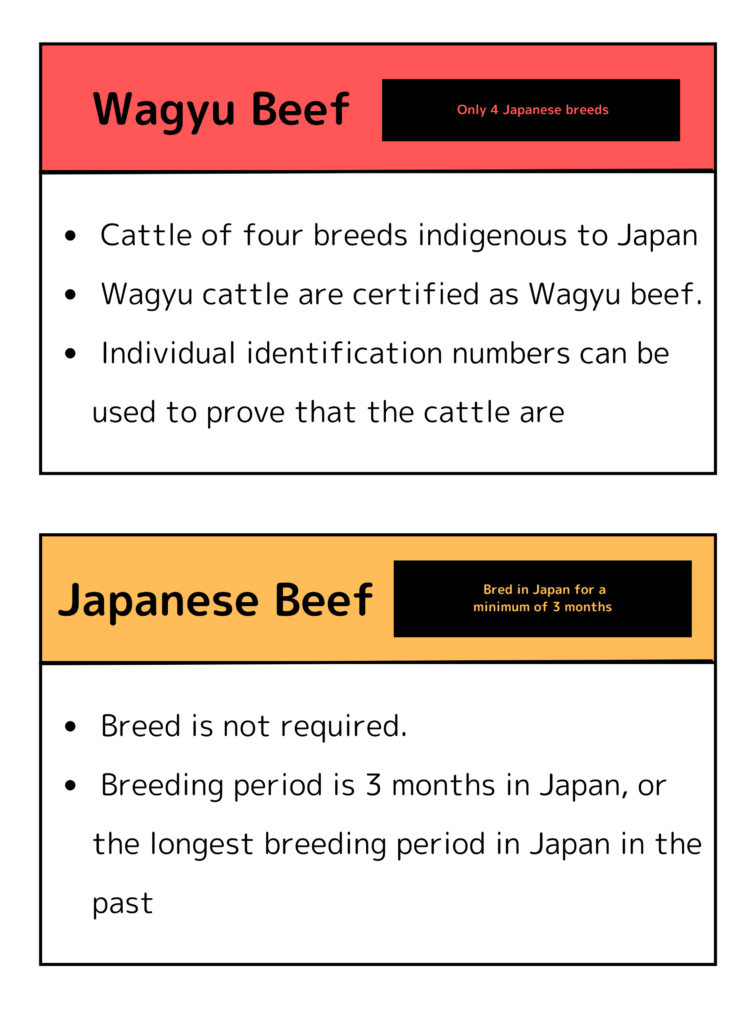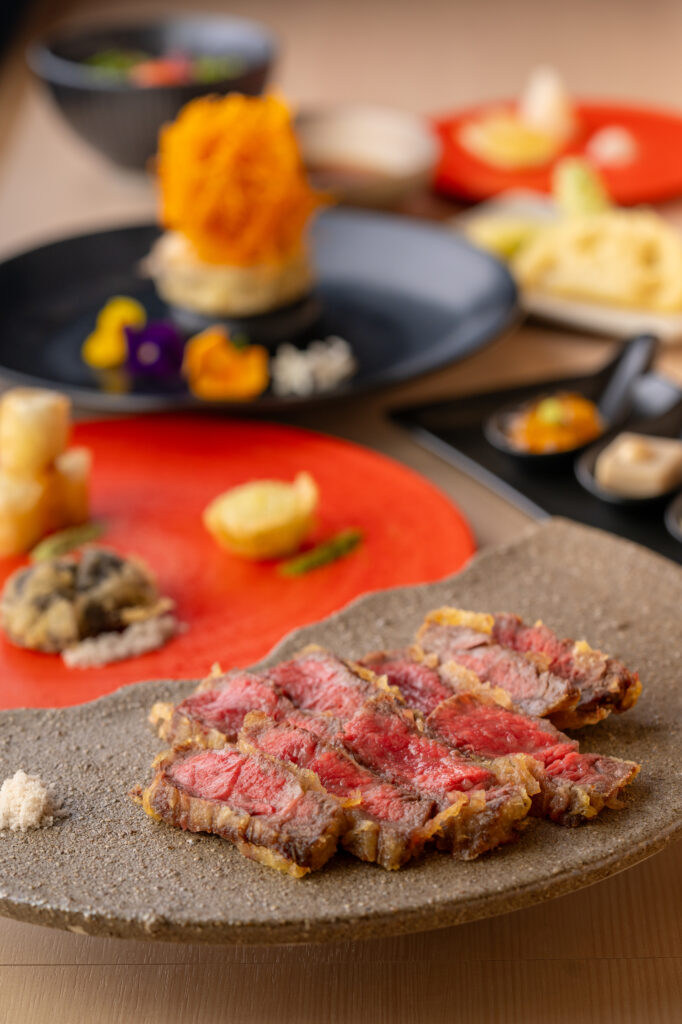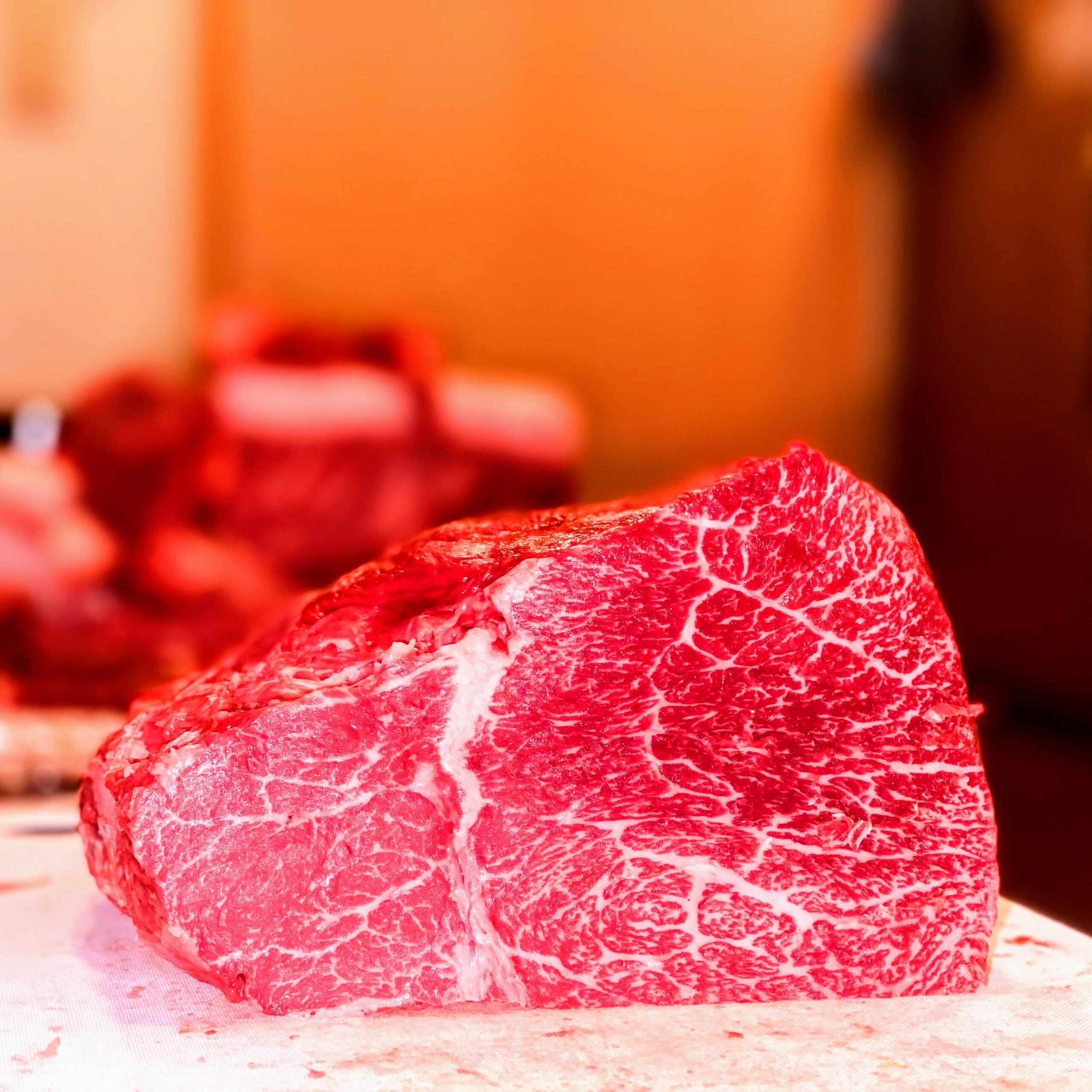Many people look forward to the food when they visit Japan, don’t they?
Popular dishes include sushi, tempura, ramen, and Wagyu beef, among others.
This time, I would like to write about “Wagyu.”
You may often see phrases like “using A5 grade Wagyu…” or “rare cuts of Wagyu…”. Similarly, the term “domestic beef” is just as common.
Wagyu and domestic beef—just looking at the words, you might think they are the same, but what’s the difference?
However, Wagyu and domestic beef are different!
So, to help you fully enjoy your meals in Japan,
- we’ll introduce the differences between the Wagyu brand and domestic beef,
- and how to understand beef grading like “A5 grade.”
目次
- What is the Difference Between Wagyu and Other Beef?
- What is Domestic Beef?
- What is Wagyu?
- The Charm and History of Wagyu
- The Four Wagyu Breeds
- Wagyu Management
- If You Want to Eat Delicious Beef, Choose “A5 Grade” Wagyu!
- The Four Criteria for Grading Beef, Including Wagyu
- The highest rating in all four categories is considered A5 rank.
- Summary
What is the Difference Between Wagyu and Other Beef?
First, for beef to be called Wagyu, it must come from specific breeds.
These breeds are “Kuroge” (Japanese Black), “Akage” (Japanese Brown), “Mukaku” (Japanese Polled), and “Nihon Tankaku” (Japanese Shorthorn).
We will explain the characteristics of each breed later, but all of these breeds must be purebred. The place of birth or raising is not specified, but only these four breeds can be called Wagyu, and they are strictly managed.
Only these four top breeds, improved for meat production, can be called “Wagyu” and are popular worldwide!
In contrast, domestic beef refers to all cattle raised in Japan for a certain period.
What is Domestic Beef?

- Cattle raised in Japan for over three months
- Cattle raised for the longest period in Japan during their rearing period
In other words, regardless of breed or place of birth, if cattle are raised in Japan for at least three months, they can be called “domestic beef.”
What is Wagyu?
Wagyu refers to beef produced from specific breeds of cattle raised in Japan.
The main differences between Wagyu and other types of beef are in:
- Genetics
- Rearing methods
- Feed
Japanese farmers manage the rearing history of all Wagyu.
The Charm and History of Wagyu
The charm of Wagyu lies in the marbling, known as “sashi.”
Marbling refers to the fine fat distribution within the muscle, giving Wagyu its unique tenderness and rich, buttery flavor. The fat melts at low temperatures, providing a melt-in-the-mouth texture.
Why did Wagyu, which moves people worldwide, come to be?
The history of Wagyu dates back over 100 years.
Traditionally, cattle in Japan were raised for agricultural purposes.
However, with the introduction of Western culture, crossbreeding with European breeds for meat production began.
Particularly, Angus and Simmental breeds were introduced to Japan and crossed with native Japanese breeds.
This crossbreeding resulted in new cattle breeds with superior meat quality, forming the foundation of today’s Wagyu.
In the 1920s, cattle born from these crosses began to be registered, and in 1944, the four Wagyu breeds were officially established.
These are Japanese Black, Japanese Brown, Japanese Shorthorn, and Japanese Polled, with Japanese Black being renowned for representing Wagyu quality.
The Strict Rearing Methods of Wagyu
Maintaining Wagyu quality requires very strict rearing methods.
Wagyu are raised in stress-free environments with the utmost care.
This is crucial for improving meat quality.
In Wagyu rearing, appropriate feed selection and environmental management are conducted, with constant monitoring of the cattle’s health and stress levels.
Special Feed
To enhance the marbling of Wagyu, special feed is provided.
The feed includes high-nutrition grains and specially mixed feed.
This promotes the cattle’s growth and fat distribution, forming rich marbling.
Managing vitamin A intake is particularly important to improve the quality of marbling.
Through such rigorous rearing methods and special feed management, Wagyu is highly valued for its exceptional quality and flavor, distinct from other beef.
The Four Wagyu Breeds
Japanese Black (Kuroge Washu)

Taste Characteristics:
The most well-known breed, making up about 90% of Wagyu.
Japanese Black is characterized by its rich marbling, with evenly distributed fat that makes the meat very tender and melt-in-the-mouth.
It has a rich buttery flavor and sweetness, boasting the highest quality.
Uses:
Steak, shabu-shabu, sukiyaki, etc.
Japanese Brown (Akage Washu)

Taste Characteristics:
Also called “red cattle,” it has more lean meat and less fat compared to Japanese Black.
This gives it a light taste while still allowing you to enjoy the rich meat flavor.
It is popular among health-conscious people.
Uses:
Steak, yakiniku, roast beef, etc.
Japanese Shorthorn (Nihon Tankaku Washu)

Taste Characteristics:
Characterized by a lot of lean meat.
It has a unique flavor that deepens as you chew, and it is popular among health-conscious individuals due to its low fat content.
Uses:
Sukiyaki, shabu-shabu, stews, etc.
Japanese Polled (Mukaku Washu)

Taste Characteristics:
Also has a lot of lean meat, but even less fat than Japanese Black.
It has a simple taste, allowing you to enjoy the pure meat flavor.
It is also noted for its high red meat content, drawing attention for beauty and health benefits.
Uses:
Yakiniku, steak, stir-fried dishes, etc.
Only these four breeds can be called “Wagyu”!
Wagyu Management
How is Wagyu managed? Only the above four breeds can be called Wagyu.
To maintain the Wagyu brand, which is proof of the highest quality beef, specialized registration and traceability systems are in place. Let’s introduce the systems supporting the Wagyu brand!
From Calf Registration to Wagyu Individual Identification Numbers
Wagyu registration began in 1920.
Currently, livestock registration organizations manage the registration of the four Wagyu breeds.
The most important management is the “calf registration,” which is done within four months after birth by regional registration inspectors.
The Wagyu calf registry is the foundation record for all registration projects.
Calf registration inspections are conducted within four months of birth at the production site by a regional registration examiner or other person.
At this time, in addition to checking the mother’s multiple certificates, the calf will be checked for wearing an individual identification ear tag and for any physical abnormalities.
From there, the individual is identified, a calf registration certificate is issued, and the breed is certified.
This record is also used to maintain the cattle’s family register and as a breeding record for the mother cow.
This is an important proof of the breed, and is the basis for gaining the trust of consumers as “Wagyu” beef.
Additionally, breeding cattle are classified based on five characteristics: pedigree, conformation, reproductive performance, offspring performance, and defect formation. The highest quality breeding cattle, classified as “superior registration,” are used for further breed improvement.
Since 2003, the Beef Traceability Law requires the attachment of individual identification ear tags during calf registration. Consumers can view the birth date, place of birth, and distribution route of purchased Wagyu using the identification number on the ear tag, which serves as proof of “Wagyu.”
As a result of these efforts to enhance the brand value of “Wagyu” nationwide, Wagyu has been recognized as the highest-grade beef worldwide.
If You Want to Eat Delicious Beef, Choose “A5 Grade” Wagyu!
In Japan, beef has a quality grade that is widely recognized as a standard of quality.
Among these, A5 grade is the highest quality grade.
A5 grade beef is synonymous with the best quality meat, and this grade applies to both domestic beef and Wagyu.
By the way, the “A” in A5 grade indicates the yield grade, showing how much meat can be obtained from one cow.
It is evaluated in three stages: A, B, and C, with A being the highest, indicating a higher yield of beef.
Therefore, the “A” in “A5” represents the yield grade, evaluating “how much meat can be supplied to the market,” and is not related to the taste or quality of the beef.

In contrast, the number “5” represents the meat quality grade.
The meat quality grade is evaluated in four categories, each rated on a scale from 1 to 5.
Only beef that receives a “5” in all four categories earns the highest grade of “5,” becoming “A5 grade.”
Even if three categories score “5” and one scores “3,” the beef will be rated as “A3.”
Simply put, choosing “A5 Wagyu” means you can’t go wrong, but let’s explain the four criteria for the A5 grade.
The Four Criteria for Grading Beef, Including Wagyu
1. Marbling Evaluation
The marbling evaluation uses a 12-step Beef Marbling Standard (B.M.S).
As this number increases, the degree of marbling increases. Marbling scores of 8 to 12 achieve a grade of 5.
2. Meat Color and Brightness Evaluation
This is a combined evaluation of meat color and brightness.
The meat color is rated on a 7-step Beef Color Standard (B.C.S).
A score of 1 is close to orange, and as the score increases to 7, the redness increases.
A good color is rated between 3 and 5. In addition to this, brightness is judged visually, and the combined result determines the grade.
3. Firmness and Texture Evaluation
This is an evaluation of meat firmness and texture.
It is judged visually, and only meat that meets both criteria receives a grade of 5.
4. Fat Color , Brightness, and Quality Evaluation
The fat color is evaluated based on the 7-step Beef Fat Standard (B.F.S).
Scores close to 1 are whiter, indicating higher quality.
Fat color scores of 1 to 4, along with excellent brightness and quality, receive a grade of 5.
The highest rating in all four categories is considered A5 rank.
The above four items are important factors for the taste of meat. Meat with a high percentage of marbling and luster is very popular and traded at a high price in the market.
The A5 rank is widely used as a standard to prove that the meat is high quality and tasty.
Summary

Everyone has their preferences when it comes to beef. Some prefer lean meat, while others love marbled meat. If you love marbling and want to enjoy beef in Japan, we recommend “A5 grade Wagyu.”
Of course, it costs more than domestic beef, but it’s worth it. If you want to enjoy Wagyu, we recommend “Chateaubriand” or “Sirloin.”
At Tempura Asakusa SAKURA, we use the highest-grade A5 Wagyu sirloin to make the most delicious tempura. Our “Luxurious Wagyu Sirloin Tempura Bowl” starts from 3800 yen, and the “Wagyu Sirloin and Vegetable Tempura Course” is 8800 yen. Please try our tempura with A5 grade Wagyu sirloin, which is also highly rated on Google Maps.
So, how can we verify whether the beef is genuine Wagyu and also meets Halal standards?
In the next article, we will introduce several reliable methods to check these points.
Tempura Asakusa SAKURA Basic information

